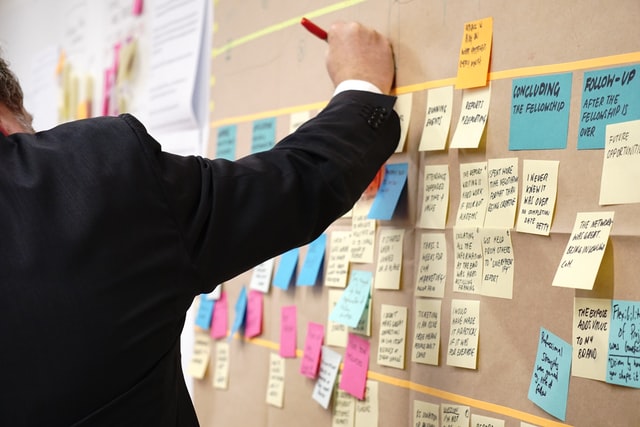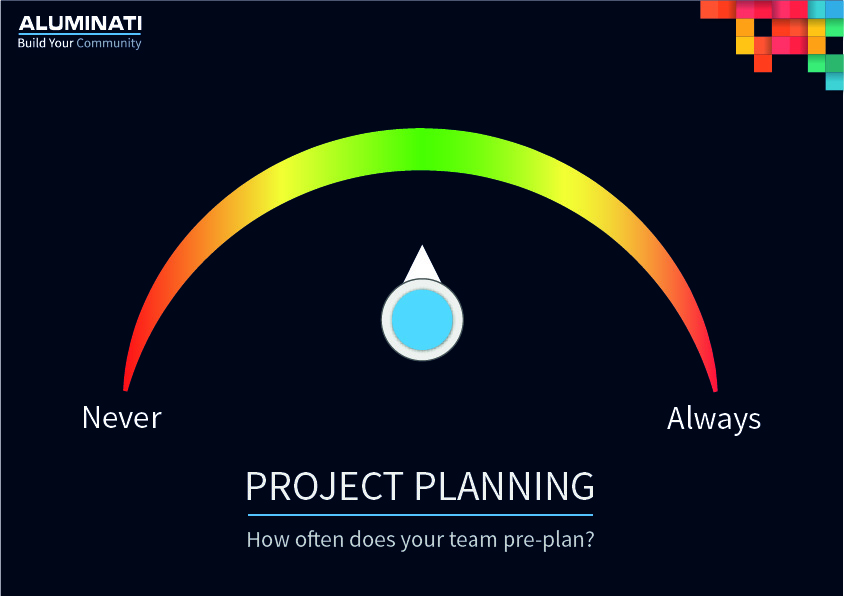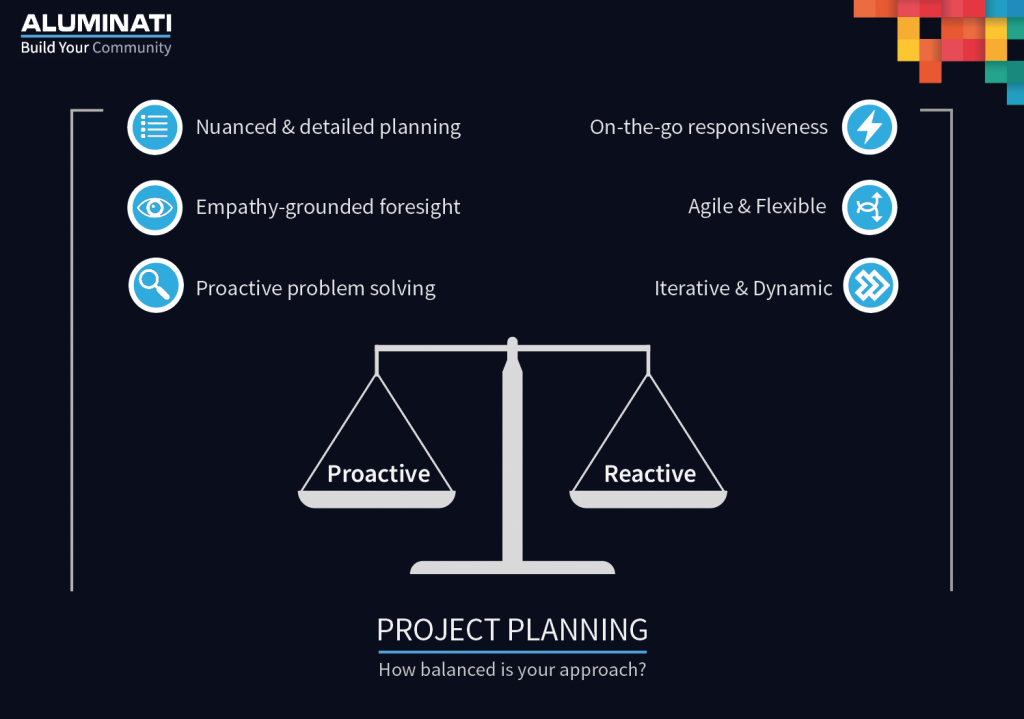Did you know that companies that develop project management practices save 28 times more money than those that do not? Or, for those of us who are constantly finding there are not enough hours in the day, did you realise that employees who are well-equipped to manage a project can save nearly 500 hours of time a year, compared to those who are ill-equipped for project management? That’s saving nearly 10 hours a week!

When it comes to community building and community management, we cannot overstate the importance of good project planning. Having a good project plan can save you time and money. We have identified ten essential management traits for community managers, and project planning overlaps with several of these traits.
Whether you’re launching a new community from scratch, working to revitalise a community in which people have stopped engaging regularly, or introducing a new aspect into your existing community, you need to plan out the project in a way that keeps your workload (and stress levels) manageable, while also creating an experience that your community members will want to engage with and be a part of. (Check out our series on Community here)
Check out Top 8 Online Community Engagement Tactics from the Experts from Chris Detzel
Designing, planning, and executing a project that attracts and draws in the individuals whom you want to participate in your community is no easy feat; planning a project that is explicitly oriented around community member participation requires both detailed foreplanning and dynamic responsiveness on the part of the community manager.
This is because a community of people, at least a healthy one, is not going to be static or 100% predictable and thus it is not possible to rely purely on formulaic pre-planned solutions. Rather, healthy communities are dynamic. And, as a result of this dynamicness, excellent community managers are able to strike a good balance between detailed on-the-go responsiveness and pre-planning details.

Some community managers, especially ones who are new to community management or who are launching a new element into their community, fall into the trap of operating only in one end of this spectrum. But the best of community managers fall somewhere in the middle. Where do you and your team fall?
If you approach your community management without any high-level structure and organisation, thinking you’ll always be able to smoothly respond to all the details as they come, or if you keep telling yourself that you’ll “cross that bridge when you come to it” you will one day find yourself running across a bridge that is already collapsing underneath you. (Or whatever analogy of utter chaos that suits you.)
For your members, this “approach” (if we can call it that) to community management tends to lead to a community experience that feels disorganized, chaotic, and thrown-together –and not in a refreshing or rejuvenating way! Your community members may even begin to question why they are participating in such a dishevelled community. As the community manager, you’ll eventually lose a lot of time trying to play catch up and introduce any semblance of order into your community planning.
The other danger, which can be equally detrimental, is to over-plan every single detail and to be so regimented in your structure and plans that you’re not able to actually respond to the situation in front of your eyes. Indeed, sometimes overplanning and over anticipating (at least without getting any concrete feedback from your members) can be its own downfall. For your members, this approach to community management tends to lead to a community experience that feels overly structured, impersonal, rigid, and mechanical. As the community manager, you’ll waste a lot of time by meticulously planning out all sorts of details in advance, only to realise that you need to dramatically adapt those plans you made 6+ months ago since they no longer fit what is needed.
The best practice for project planning falls somewhere in between these two extremes.

In our facilitation sessions with clients, Aluminati consultants help community managers and their teams to strike the right balance in their project planning. Clients tend to prefer our five-session facilitation pack, in which Project Planning is 1 of 5 themes that we cover, but we also offer 1-off facilitation sessions on Project Planning or even deep-dive experiences depending on your needs.
When we work with clients on project planning, we guide you to think through a few different steps of project planning and ensure that you have an appropriate strategy in place to meet your needs based on your staff resourcing. In our experience, these strategies are best uncovered and co-created through a guided process with an external expert–which is why so many of our clients find it substantially easier to move forward after they have had a guided facilitation session with us, even if they’ve already done initial brainstorming work as a team.
Whether or not we become an active part of the strategy process with you through a guided session or deep dive consultancy, we want to help set you and your team up for success.
Here are four of the top elements to include in your team’s process when creating your project plan:
1. Define your top-level strategy
This starts with the “why” behind why are you building a community in the first place (what does your organisation want to get out of it?) and concurrently thinking through the “why” behind why your different members would want to join your community (what do they get from joining? What do they want from you? Or from other members?) In a great 5-minute summary video, Simon Sinek guides leaders through thinking about the Why, How, and What of their organisation.
2. Align your team on the key dates, actions, and plan for maintaining your community
This is best done by creating a detailed list of actions that your team will need to cover in the next ~8 months (we sometimes focus up to 10 months, but do not recommend doing any granular detail for more than 1 year in advance). A Gannt chart might do the trick. But if you’re working with multiple team members (or even across multiple teams) you’ll probably benefit from a project management tool. Keep Productive has shortlisted the top 10 project management tools to help teams organize and collaborate on their work. (Our team uses Monday.com!)
Aligning on your key dates and actions is not just with regard to your external-facing communication (we’ll return to that in a different post) though it should include that overview as well. This project plan should be more holistic. Whether it’s deciding when to send a particular email to a segmented group within your community, or knowing just how often to take a look at data that tells you how well your community engagement is going, these things should be planned for in advance.
3. Create an internal workflow for the new project and make sure everyone understands what they offer to the group and who they go to for certain things.
Your team has probably already established a workflow that works quite well for your current dynamics. But the thing is, whenever you are launching a new community or introducing a new element to your existing community, it can create the perfect storm: an existing team with a new dynamic often results in things falling between the cracks unless a proper plan is set in place. When we run our facilitation sessions, our ears are attuned to see gaps in team members’ expected workflow and we work with you to help you figure out how to patch the gaps up and create a smooth workflow.
4. Start thinking about your data and analytics
We have found that this merits an entire facilitation session, and we usually cover KPIs and Success Metrics in more detail in its own session (we’ll write more about it in an upcoming post. If you haven’t already done so, make sure you subscribe to our blog and follow us on LinkedIn. ) But it’s important to at least have a bird’s eye view of understanding of your KPIs and Success metrics so that you can understand what data to track and how regularly you want to check it. We encourage our community managers to spend one afternoon a month (or roughly 5 hours) pulling the appropriate data from their back-end analytics and assessing how you are doing against your benchmarks. Working this time into your project plan early on is a crucial step so that you don’t let it get pushed to the back burner once you’re in full swing of the project and are too busy to think about data collection and analysis.
If you’re interested in learning more about the consultancy offerings of our in-house consultants, get in touch with us!





